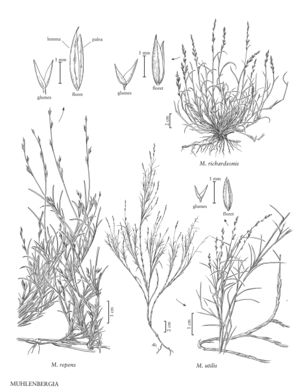Difference between revisions of "Muhlenbergia utilis"
FNA>Volume Importer |
FNA>Volume Importer |
||
| Line 17: | Line 17: | ||
-->{{Treatment/Body | -->{{Treatment/Body | ||
|distribution=Calif.;Ariz.;Tex.;Nev. | |distribution=Calif.;Ariz.;Tex.;Nev. | ||
| − | |discussion=<p>Muhlenbergia utilis grows in wet soils along streams, ponds, and depressions in grasslands and alkaline or gypsiferous plains, at elevations of 200-1800 m. Its range extends from the southern United States through Mexico to Costa Rica.</p> | + | |discussion=<p><i>Muhlenbergia utilis</i> grows in wet soils along streams, ponds, and depressions in grasslands and alkaline or gypsiferous plains, at elevations of 200-1800 m. Its range extends from the southern United States through Mexico to Costa Rica.</p> |
|tables= | |tables= | ||
|references= | |references= | ||
| Line 26: | Line 26: | ||
-->{{#Taxon: | -->{{#Taxon: | ||
name=Muhlenbergia utilis | name=Muhlenbergia utilis | ||
| − | |||
|authority=(Torr.) Hitchc. | |authority=(Torr.) Hitchc. | ||
|rank=species | |rank=species | ||
| Line 33: | Line 32: | ||
|basionyms= | |basionyms= | ||
|family=Poaceae | |family=Poaceae | ||
| − | |illustrator=Linda A. Vorobik | + | |illustrator=Linda A. Vorobik;Annaliese Miller |
| + | |illustration copyright=Utah State University | ||
|distribution=Calif.;Ariz.;Tex.;Nev. | |distribution=Calif.;Ariz.;Tex.;Nev. | ||
|reference=None | |reference=None | ||
| Line 39: | Line 39: | ||
|publication year= | |publication year= | ||
|special status= | |special status= | ||
| − | |source xml=https:// | + | |source xml=https://jpend@bitbucket.org/aafc-mbb/fna-data-curation.git/src/f50eec43f223ca0e34566be0b046453a0960e173/coarse_grained_fna_xml/V25/V25_749.xml |
|subfamily=Poaceae subfam. Chloridoideae | |subfamily=Poaceae subfam. Chloridoideae | ||
|tribe=Poaceae tribe Cynodonteae | |tribe=Poaceae tribe Cynodonteae | ||
Revision as of 21:37, 16 December 2019
Plants perennial; rhizomatous, not cespitose. Culms 7-30 cm tall, 0.5-1 mm thick, erect to decumbent; internodes mostly smooth to slightly nodulose, minutely pubescent or glabrous below the nodes. Sheaths shorter or longer than the internodes, glabrous; ligules 0.2-0.8 mm, membranous, truncate; blades 0.5-4.7 cm long, 0.2-1.8 mm wide, usually involute, sometimes flat, often at right angles to the culm, glabrous abaxially, hirtellous adaxially. Panicles 1-5 cm long, 0.1-0.4 cm wide, contracted, usually partially included in the upper sheaths, rachises usually visible between the branches; primary branches 0.2-1.2 cm, usually closely appressed at maturity, rarely diverging up to 30° from the rachises; pedicels 0.1-1.1 mm, glabrous. Spikelets 1.4-2.4 mm. Glumes subequal, 0.5-1.4 mm, 1/3 – 1/2 as long as the lemmas, yellowish to light green, glabrous, 1(2-3)-veined, acute, unawned; lemmas 1.3-2.4 mm, lanceolate, green or purplish, glabrous or the calluses and margins appressed-pubescent, hairs shorter than 0.3 mm, apices acute, unawned; paleas 1-2 mm, lanceolate, glabrous, acute; anthers 0.7-1.4 mm, yellow to purplish. Caryopses 0.7-1.2 mm, ellipsoid to ovoid, brown. 2n = 20.
Distribution
Calif., Ariz., Tex., Nev.
Discussion
Muhlenbergia utilis grows in wet soils along streams, ponds, and depressions in grasslands and alkaline or gypsiferous plains, at elevations of 200-1800 m. Its range extends from the southern United States through Mexico to Costa Rica.
Selected References
None.
